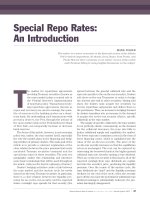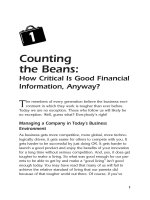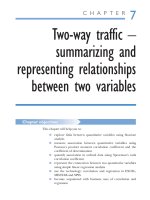QUANTITATIVE FINANCE FOR PHYSICISTS: AN INTRODUCTION pot
Bạn đang xem bản rút gọn của tài liệu. Xem và tải ngay bản đầy đủ của tài liệu tại đây (1.37 MB, 179 trang )
TeAM
YYeP
G
Digitally signed by
TeAM YYePG
DN: cn=TeAM
YYePG, c=US,
o=TeAM YYePG,
ou=TeAM YYePG,
email=yyepg@msn.
com
Reason: I attest to the
accuracy and integrity
of this document
Date: 2005.06.16
05:44:41 +08'00'
QUANTITATIVE FINANCE
FOR
PHYSICISTS:
A
N INTRODUCTION
Schmidt / Quantitative Finance: An Introduction For Physicists Final Proof 26.10.2004 9:03pm page 1
This page intentionally left blank
QUANTITATIVE FINANCE
FOR
PHYSICISTS:
A
N INTRODUCTION
ANATOLY B. SCHMIDT
AMSTERDAM • BOSTON • HEIDELBERG • LONDON
NEW YORK • OXFORD • PARIS • SAN DIEGO
SAN FRANCISCO • SINGAPORE • SYDNEY • TOKYO
Schmidt / Quantitative Finance: An Introduction For Physicists Final Proof 26.10.2004 9:03pm page 3
Elsevier Academic Press
30 Corporate Drive, Suite 400, Burlington, MA 01803, USA
525 B Street, Suite 1900, San Diego, California 92101-4495, USA
84 Theobald’s Road, London WC1X 8RR, UK
This book is printed on acid-free paper.
Copyright # 2005, Elsevier Inc. All rights reserved.
No part of this publication may be reproduced or transmitted in any form or by any
means, electronic or mechanical, including photocopy, recording, or any information
storage and retrieval system, without permission in writing from the publisher.
Permissions may be sought directly from Elsevier’s Science & Technology Rights
Department in Oxford, UK: phone: (þ44) 1865 843830, fax: (þ44) 1865 853333,
e-mail: You may also complete your request on-line
via the Elsevier homepage (), by selecting ‘‘Customer Support’’
and then ‘‘Obtaining Permissions.’’
Library of Congress Cataloging-in-Publication Data
Application submitted.
British Library Cataloguing in Publication Data
A catalogue record for this book is available from the British Library
ISBN: 0-12-088464-X
For all information on all Elsevier Academic Press publications visit our Web site at
www.books.elsevier.com
Printed in the United States of America
040506070809987654321
Schmidt / Quantitative Finance: An Introduction For Physicists Final Proof 26.10.2004 9:03pm page 4
Table of Contents
Chapter 1
Introduction 1
Chapter 2
Financial Markets 5
Chapter 3
Probability Distributions 17
Chapter 4
Stochastic Processes 29
Chapter 5
Time Series Analysis 43
Chapter 6
Fractals 59
Chapter 7
Nonlinear Dynamical Systems 69
Chapter 8
Scaling in Financial Time Series 87
Schmidt / Quantitative Finance: An Introduction For Physicists Final Proof 26.10.2004 9:03pm page 5
v
Chapter 9
Option Pricing 93
Chapter 10
Portfolio Management 111
Chapter 11
Market Risk Measurement 121
Chapter 12
Agent-Based Modeling of Financial Markets 129
Comments 145
References 149
Answers to Exercises 159
Index 161
vi Contents
Schmidt / Quantitative Finance: An Introduction For Physicists Final Proof 26.10.2004 9:03pm page 6
Detailed Table of Contents
1. Introduction 1
2. Financial Markets 5
2.1 Market Price Formation 5
2.2 Returns and Dividends 7
2.2.1 Simple and Compounded Returns 7
2.2.2 Dividend Effects 8
2.3 Market Efficiency 11
2.3.1 Arbitrage 11
2.3.2 Efficient Market Hypothesis 12
2.4 Pathways for Further Reading 14
2.5 Exercises 15
3. Probability Distributions 17
3.1 Basic Definitions 17
3.2 Important Distributions 20
3.3 Stable Distributions and Scale Invariance 25
3.4 References for Further Reading 27
3.5 Exercises 27
4. Stochastic Processes 29
4.1 Markov Processes 29
4.2 Brownian Motion 32
4.3 Stochastic Differential Equation 35
4.4 Stochastic Integral 36
4.5 Martingales 39
4.6 References for Further Reading 41
4.7 Exercises 41
Schmidt / Quantitative Finance: An Introduction For Physicists Final Proof 26.10.2004 9:03pm page 7
vii
5. Time Series Analysis 43
5.1 Autoregressive and Moving Average Models 43
5.1.1 Autoregressive Model 43
5.1.2 Moving Average Models 45
5.1.3 Autocorrelation and Forecasting 47
5.2 Trends and Seasonality 49
5.3 Conditional Heteroskedasticity 51
5.4 Multivariate Time Series 54
5.5 References for Further Reading and Econometric
Software 57
5.6 Exercises 57
6. Fractals 59
6.1 Basic Definitions 59
6.2 Multifractals 63
6.3 References for Further Reading 67
6.4 Exercises 67
7. Nonlinear Dynamical Systems 69
7.1 Motivation 69
7.2 Discrete Systems: Logistic Map 71
7.3 Continuous Systems 75
7.4 Lorenz Model 79
7.5 Pathways to Chaos 82
7.6 Measuring Chaos 83
7.7 References for Further Reading 86
7.8 Exercises 86
8. Scaling in Financial Time Series 87
8.1 Introduction 87
8.2 Power Laws in Financial Data 88
8.3 New Developments 90
8.4 References for Further Reading 92
8.5 Exercises 92
9. Option Pricing 93
9.1 Financial Derivatives 93
9.2 General Properties of Options 94
9.3 Binomial Trees 98
9.4 Black-Scholes Theory 101
9.5 References for Further reading 105
viii Detailed Table of Contents
Schmidt / Quantitative Finance: An Introduction For Physicists Final Proof 26.10.2004 9:03pm page 8
9.6 Appendix. The Invariant of the Arbitrage-Free
Portfolio 105
9.7 Exercises 109
10. Portfolio Management 111
10.1 Portfolio Selection 111
10.2 Capital Asset Pricing Model (CAPM) 114
10.3 Arbitrage Pricing Theory (APT) 116
10.4 Arbitrage Trading Strategies 118
10.5 References for Further Reading 120
10.6 Exercises 120
11. Market Risk Measurement 121
11.1 Risk Measures 121
11.2 Calculating Risk 125
11.3 References for Further Reading 127
11.4 Exercises 127
12. Agent-Based Modeling of Financial Markets 129
12.1 Introduction 129
12.2 Adaptive Equilibrium Models 130
12.3 Non-Equilibrium Price Models 134
12.4 Modeling of Observable Variables 136
12.4.1 The Framework 136
12.4.2 Price-Demand Relations 138
12.4.3 Why Technical Trading May Be Successful 139
12.4.4 The Birth of a Liquid Market 141
12.5 References for Further Reading 143
12.6 Exercises 143
Comments 145
References 149
Answers to Exercises 159
Index 161
Detailed Table of Contents ix
Schmidt / Quantitative Finance: An Introduction For Physicists Final Proof 26.10.2004 9:03pm page 9
This page intentionally left blank
Chapter 1
Introduction
This book is written for those physicists who want to work on Wall
Street but have not bothered to read anything about Finance. This is
a crash course that the author, a physicist himself, needed when he
landed a financial data analyst job and became fascinated with the
huge data sets at his disposal. More broadly, this book addresses the
reader with some background in science or engineering (college-level
math helps) who is willing to learn the basic concepts and quantitative
methods used in modern finance.
The book loosely consists of two parts: the ‘‘applied’’ part and the
‘‘academic’’ one. Two major fields, Econometrics and Mathematical
Finance, constitute the applied part of the book. Econometrics can be
broadly defined as the methods of model-based statistical inference in
financial economics [1]. This book follows the traditional definition
of Econometrics that focuses primarily on the statistical analysis of
economic and financial time series [2]. The other field is Mathematical
Finance [3, 4]. This term implies that finance has given a rise to
several new mathematical theories. The leading directions in
Mathematical Finance include portfolio theory, option-pricing
theory, and risk measurement.
The ‘‘academic’’ part of this book demonstrates that financial data
can be an area of exciting theoretical research, which might be of
interest to physicists regardless of their career motivation. This part
includes the Econophysics topics and the agent-based modeling of
1
Schmidt / Quantitative Finance: An Introduction For Physicists Final Proof 25.10.2004 11:18am page 1
financial markets.
1
Physicists use the term Econophysics to emphasize
the concepts of theoretical physics (e.g., scaling, fractals, and chaos)
that are applied to the analysis of economic and financial data. This
field was formed in the early 1990s, and it has been growing rapidly
ever since. Several books on Econophysics have been published to date
[5–11] as well as numerous articles in the scientific periodical journals
such as Physica A and Quantitative Finance.
2
The agent-based model-
ing of financial markets was introduced by mathematically inclined
economists (see [12] for a review). Not surprisingly, physicists, being
accustomed to the modeling of ‘‘anything,’’ have contributed into this
field, too [7, 10].
Although physicists are the primary audience for this book, two
other reader groups may also benefit from it. The first group includes
computer science and mathematics majors who are willing to work (or
have recently started a career) in the finance industry. In addition, this
book may be of interest to majors in economics and finance who are
curious about Econophysics and agent-based modeling of financial
markets. This book can be used for self-education or in an elective
course on Quantitative Finance for science and engineering majors.
The book is organized as follows. Chapter 2 describes the basics of
financial markets. Its topics include market price formation, returns
and dividends, and market efficiency. The next five chapters outline
the theoretical framework of Quantitative Finance: elements of math-
ematical statistics (Chapter 3), stochastic processes (Chapter 4), time
series analysis (Chapter 5), fractals (Chapter 6), and nonlinear dy-
namical systems (Chapter 7). Although all of these subjects have been
exhaustively covered in many excellent sources, we offer this material
for self-contained presentation.
In Chapter 3, the basic notions of mathematical statistics are
introduced and several popular probability distributions are listed.
In particular, the stable distributions that are used in analysis of
financial time series are discussed.
Chapter 4 begins with an introduction to the Wiener process, which
is the basis for description of the stochastic financial processes. Three
methodological approaches are outlined: one is rooted in the generic
Markov process, the second one is based on the Langevin equation,
and the last one stems from the discrete random walk. Then the basics
of stochastic calculus are described. They include the Ito’s lemma and
2 Introduction
Schmidt / Quantitative Finance: An Introduction For Physicists Final Proof 25.10.2004 11:18am page 2
the stochastic integral in both the Ito and the Stratonovich forms.
Finally, the notion of martingale is introduced.
Chapter 5 begins with the univariate autoregressive and moving
average models, the classical tools of the time series analysis. Then the
approaches to accounting for trends and seasonality effects are dis-
cussed. Furthermore, processes with non-stationary variance (condi-
tional heteroskedasticity) are described. Finally, the specifics of the
multivariate time series are outlined.
In Chapter 6, the basic definitions of the fractal theory are dis-
cussed. The concept of multifractals, which has been receiving a lot of
attention in recent financial time series research, is also introduced.
Chapter 7 describes the elements of nonlinear dynamics that are
important for agent-based modeling of financial markets. To illustrate
the major concepts in this field, two classical models are discussed: the
discrete logistic map and the continuous Lorenz model. The main
pathways to chaos and the chaos measures are also outlined.
Those readers who do not need to refresh their knowledge of the
mathematical concepts may skip Chapters 3 through 7.
3
The other five chapters are devoted to financial applications. In
Chapter 8, the scaling properties of the financial time series are
discussed. The main subject here is the power laws manifesting in
the distributions of returns. Alternative approaches in describing the
scaling properties of the financial time series including the multifrac-
tal models are also outlined.
The next three chapters, Chapters 9 through 11, relate specifically
to Mathematical Finance. Chapter 9 is devoted to the option pricing.
It starts with the general properties of stock options, and then the
option pricing theory is discussed using two approaches: the method
of the binomial trees and the classical Black-Scholes theory.
Chapter 10 is devoted to the portfolio theory. Its basics include the
capital asset pricing model and the arbitrage pricing theory. Finally,
several arbitrage trading strategies are listed. Risk measurement is the
subject of Chapter 11. It starts with the concept of value at risk, which
is widely used in risk management. Then the notion of coherent risk
measure is introduced and one such popular measure, the expected
tail losses, is described.
Finally, Chapter 12 is devoted to agent-based modeling of financial
markets. Two elaborate models that illustrate two different
Introduction 3
Schmidt / Quantitative Finance: An Introduction For Physicists Final Proof 25.10.2004 11:18am page 3
approaches to defining the price dynamics are described. The first one
is based on the supply-demand equilibrium, and the other approach
employs an empirical relation between price change and excess
demand. Discussion of the model derived in terms of observable
variables concludes this chapter.
The bibliography provides the reader with references for further
reading rather than with a comprehensive chronological review. The
reference list is generally confined with recent monographs and
reviews. However, some original work that either has particularly
influenced the author or seems to expand the field in promising
ways is also included.
In every chapter, exercises with varying complexity are provided.
Some of these exercises simply help the readers to get their hands on
the financial market data available on the Internet and to manipulate
the data using Microsoft Excel software.
4
Other exercises provide a
means of testing the understanding of the book’s theoretical material.
More challenging exercises, which may require consulting with ad-
vanced textbooks or implementation of complicated algorithms, are
denoted with an asterisk. The exercises denoted with two asterisks
offer discussions of recent research reports. The latter exercises may
be used for seminar presentations or for course work.
A few words about notations. Scalar values are denoted with the
regular font (e.g., X) while vectors and matrices are denoted with
boldface letters (e.g., X). The matrix transposes are denoted with
primes (e.g., X
0
) and the matrix determinants are denoted with vertical
bars (e.g., jXj). The following notations are used interchangeably:
X(t
k
) X(t) and X(t
kÀ1
) X(t À 1). E[X] is used to denote the ex-
pectation of the variable X.
The views expressed in this book may not reflect the views of my
former and current employers. While conducting the Econophysics
research and writing this book, I enjoyed support from Blake LeBaron,
Thomas Lux, Sorin Solomon, and Eugene Stanley. I am also indebted
to anonymous reviewers for attentive analysis of the book’s drafts.
Needless to say, I am solely responsible for all possible errors present in
this edition. I will greatly appreciate all comments about this book;
please send them to
Alec Schmidt
Cedar Knolls, NJ, June 2004
4 Introduction
Schmidt / Quantitative Finance: An Introduction For Physicists Final Proof 25.10.2004 11:18am page 4
Chapter 2
Financial Markets
This chapter begins with a description of market price formation. The
notion of return that is widely used for analysis of the investment
efficiency is introduced in Section 2.2. Then the dividend effects on
return and the present-value pricing model are described. The next big
topic is market efficiency (Section 2.3). First, the notion of arbitrage is
defined. Then the Efficient Market Hypothesis, both the theory and
its critique, are discussed. The pathways for further reading in Section
2.4 conclude the chapter.
2.1 MARKET PRICE FORMATION
Millions of different financial assets (stocks, bonds, currencies,
options, and others) are traded around the world. Some financial
markets are organized in exchanges or bourses (e.g., New York
Stock Exchange (NYSE)). In other, so-called over-the-counter
(OTC) markets, participants operate directly via telecommunication
systems. Market data are collected and distributed by markets them-
selves and by financial data services such as Bloomberg and Reuters.
Modern electronic networks facilitate access to huge volumes of
market data in real time.
Market prices are formed with the trader orders (quotes) submitted
on the bid (buy) and ask (sell) sides of the market. Usually, there is a
5
Schmidt / Quantitative Finance: An Introduction For Physicists Final Proof 25.10.2004 11:19am page 5
spread between the best (highest) bid and the best (lowest) ask prices,
which provides profits for the market makers. The prices seen on the
tickers of TV networks and on the Internet are usually the transaction
prices that correspond to the best prices. The very presence of trans-
actions implies that some traders submit market orders; they buy at
current best ask prices and sell at current best bid prices. The trans-
action prices represent the mere tip of an iceberg beneath which prices
of the limit orders reside. Indeed, traders may submit the sell orders at
prices higher than the best bid and the buy orders at prices lower than
the best ask. The limit orders reflect the trader expectations of future
price movement. There are also stop orders designated to limit pos-
sible losses. For an asset holder, the stop order implies selling assets if
the price falls to a predetermined value.
Holding assets, particularly holding derivatives (see Section 9.1), is
called long position. The opposite of long buying is short selling, which
means selling assets that the trader does not own after borrowing
them from the broker. Short selling makes sense if the price is
expected to fall. When the price does drop, the short seller buys the
same number of assets that were borrowed and returns them to the
broker. Short sellers may also use stop orders to limit their losses in
case the price grows rather than falls. Namely, they may submit the
stop order for triggering a buy when the price reaches a predeter-
mined value.
Limit orders and stop orders form the market microstructure: the
volume-price distributions on the bid and ask sides of the market. The
concept market liquidity is used to describe price sensitivity to market
orders. For instance, low liquidity means that the number of securities
available at the best price is smaller than a typical market order. In this
case, a new market order is executed within a range of available prices
rather than at a single best price. As a result, the best price changes its
value. Securities with very low liquidity may have no transactions and
few (if any) quotes for some time (in particular, the small-cap stocks off
regular trading hours). Market microstructure information usually is
not publicly available. However, the market microstructure may be
partly revealed in the price reaction to big block trades.
Any event that affects the market microstructure (such as submis-
sion, execution, or withdrawal of an order) is called a tick. Ticks are
recorded along with the time they are submitted (so-called tick-by-tick
6 Financial Markets
Schmidt / Quantitative Finance: An Introduction For Physicists Final Proof 25.10.2004 11:19am page 6
data). Generally, tick-by-tick data are not regularly spaced in time,
which leads to additional challenges for high-frequency data analysis
[1, 2]. Current research of financial data is overwhelmingly conducted
on the homogeneous grids that are defined with filtering and aver-
aging tick-by-tick data.
Another problem that complicates analysis of long financial time
series is seasonal patterns. Business hours, holidays, and even daylight
saving time shifts affect market activity. Introducing the dummy
variables into time series models is a general method to account for
seasonal effects (see Section 5.2). In another approach, ‘‘operational
time’’ is employed to describe the non-homogeneity of business activ-
ity [2]. Non-trading hours, including weekends and holidays, may be
cut off from operational time grids.
2.2 RETURNS AND DIVIDENDS
2.2.1 S
IMPLE AND COMPOUNDED RETURNS
While price P is the major financial variable, its logarithm,
p ¼ log (P) is often used in quantitative analysis. The primary reason
for using log prices is that simulation of a random price innovation
can move price into the negative region, which does not make sense.
In the mean time, negative logarithm of price is perfectly acceptable.
Another important financial variable is the single-period return (or
simple return) R(t) that defines the return between two subsequent
moments t and tÀ1. If no dividends are paid,
R(t) ¼ P(t)=P(t À 1) À 1(2:2:1)
Return is used as a measure of investment efficiency.
1
Its advantage is
that some statistical properties, such as stationarity, may be more
applicable to returns rather than to prices [3]. The simple return of a
portfolio, R
p
(t), equals the weighed sum of returns of the portfolio
assets
R
p
(t) ¼
X
N
i¼1
w
ip
R
ip
(t),
X
N
i¼1
w
ip
¼ 1, (2:2:2)
where R
ip
and w
ip
are return and weight of the i-th portfolio asset,
respectively; i ¼ 1, ,N.
Financial Markets 7
Schmidt / Quantitative Finance: An Introduction For Physicists Final Proof 25.10.2004 11:19am page 7
The multi-period returns, or the compounded returns, define the
returns between the moments t and t À k þ 1. The compounded
return equals
R(t, k) ¼ [R(t) þ 1] [R(t À 1) þ 1] [R(t À k þ 1) þ 1] þ 1
¼ P(t)=P(t À k) þ 1(2:2:3)
The return averaged over k periods equals
ˇ
R(t, k) ¼
Y
kÀ1
i¼0
(R(t À i) þ 1)
"#
1=k
À1(2:2:4)
If the simple returns are small, the right-hand side of (2.2.4) can be
reduced to the first term of its Taylor expansion:
ˇ
R(t, k) %
1
k
X
kÀ1
i¼1
R(t, i) (2:2:5)
The continuously compounded return (or log return) is defined as:
r(t) ¼ log [R(t) þ 1] ¼ p(t) À p(t À 1) (2:2:6)
Calculation of the compounded log returns is reduced to simple
summation:
r(t, k) ¼ r(t) þ r(t À 1) þ þ r(t À k þ 1) (2:2:7)
However, the weighing rule (2.2.2) is not applicable to the log returns
since log of sum is not equal to sum of logs.
2.2.2 DIVIDEND EFFECTS
If dividends D(t þ 1) are paid within the period [t, t þ 1], the simple
return (see 2.2.1) is modified to
R(t þ 1) ¼ [P(t þ 1) þ D(t þ 1) ]=P(t) À 1(2:2:8)
The compounded returns and the log returns are calculated in the
same way as in the case with no dividends.
Dividends play a critical role in the discounted-cash-flow (or pre-
sent-value) pricing model. Before describing this model, let us intro-
duce the notion of present value. Consider the amount of cash K
invested in a risk-free asset with the interest rate r. If interest is paid
8 Financial Markets
Schmidt / Quantitative Finance: An Introduction For Physicists Final Proof 25.10.2004 11:19am page 8
every time interval (say every month), the future value of this cash
after n periods is equal to
FV ¼ K(1 þ r)
n
(2:2:9)
Suppose we are interested in finding out what amount of money will
yield given future value after n intervals. This amount (present value)
equals
PV ¼ FV=(1 þ r)
n
(2:2:10)
Calculating the present value via the future value is called discounting.
The notions of the present value and the future value determine the
payoff of so-called zero-coupon bonds. These bonds sold at their
present value promise a single payment of their future value at ma-
turity date.
The discounted-cash-flow model determines the stock price via its
future cash flow. For the simple model with the constant return
E[R(t) ] ¼ R, one can rewrite (2.2.8) as
P(t) ¼ E[{P(t þ 1) þ D(t þ 1)}=(1 þ R)] (2:2:11)
If this recursion is repeated K times, one obtains
P(t) ¼ E
X
K
i¼1
D(t þ i)=(1 þ R)
i
"#
þ E[P(t þ K)=(1 þ R)
K
](2:2:12)
In the limit K !1, the second term in the right-hand side of (2.2.12)
can be neglected if
lim
K!1
E[P(t þ K)=(1 þ R)
K
] ¼ 0(2:2:13)
Then the discounted-cash-flow model yields
P
D
(t) ¼ E
X
1
i¼1
D(t þ i)=(1 þ R)
i
"#
(2:2:14)
Further simplification of the discounted-cash-flow model is based on
the assumption that the dividends grow linearly with rate G
E[D(t þ i) ] ¼ (1 þ G)
i
D(t) (2:2:15)
Then (2.2.14) reduces to
Financial Markets 9
Schmidt / Quantitative Finance: An Introduction For Physicists Final Proof 25.10.2004 11:19am page 9
P
D
(t) ¼
1 þ G
R À G
D(t) (2:2:16)
Obviously, equation (2.2.16) makes sense only for R > G. The value
of R that may attract investors is called the required rate of return.
This value can be treated as the sum of the risk-free rate and the asset
risk premium. While the assumption of linear dividend growth is
unrealistic, equation (2.2.16) shows the high sensitivity of price to
change in the discount rate R when R is close to G (see Exercise 2). A
detailed analysis of the discounted-cash-flow model is given in [3].
If the condition (2.2.13) does not hold, the solution to (2.2.12) can
be presented in the form
P(t) ¼ P
D
(t) þ B(t), B(t) ¼ E[B(t þ 1)=(1 þ R) ] (2:2:17)
The term P
D
(t) has the sense of the fundamental value while the
function B(t) is often called the rational bubble. This term implies
that B(t) may lead to unbounded growth—the ‘‘bubble.’’ Yet, this
bubble is ‘‘rational’’ since it is based on rational expectations of future
returns. In the popular Blanchard-Watson model
B(t þ1) ¼
1 þR
p
B(t) þe(t þ1) with probability p,0< p < 1
e(t þ1) with probability 1 Àp
(2:2:18)
(
where e(t) is an independent and identically distributed process (IID)
2
with E[e(t) ] ¼ 0. The specific of this model is that it describes period-
ically collapsing bubbles (see [4] for the recent research).
So far, the discrete presentation of financial data was discussed.
Clearly, market events have a discrete nature and price variations
cannot be smaller than certain values. Yet, the continuum presenta-
tion of financial processes is often employed [5]. This means that the
time interval between two consecutive market events compared to the
time range of interest is so small that it can be considered an infini-
tesimal difference. Often, the price discreteness can also be neglected
since the markets allow for quoting prices with very small differen-
tials. The future value and the present value within the continuous
presentation equal, respectively
FV ¼ K exp (rt), PV ¼ FV exp (Àrt) (2:2:19)
In the following chapters, both the discrete and the continuous pre-
sentations will be used.
10 Financial Markets
Schmidt / Quantitative Finance: An Introduction For Physicists Final Proof 25.10.2004 11:19am page 10
2.3 MARKET EFFICIENCY
2.3.1 A
RBITRAGE
Asset prices generally obey the Law of One Price, which says that
prices of equivalent assets in competitive markets must be the same
[6]. This implies that if a security replicates a package of other
securities, the price of this security and the price of the package it
replicates must be equal. It is expected also that the asset price must
be the same worldwide, provided that it is expressed in the same
currency and that the transportation and transaction costs can be
neglected. Violation of the Law of One Price leads to arbitrage, which
means buying an asset and immediate selling it (usually in another
market) with profit and without risk. One widely publicized example
of arbitrage is the notable differences in prices of prescription drugs in
the USA, Europe, and Canada. Another typical example is the so-
called triangle foreign exchange arbitrage. Consider a situation in
which a trader can exchange one American dollar (USD) for one
Euro (EUR) or for 120 Yen (JPY). In addition, a trader can exchange
one EUR for 119 JPY. Hence, in terms of the exchange rates, 1 USD/
JPY > 1 EUR/JPY * 1 USD/EUR.
3
Obviously, the trader who
operates, say 100000 USD, can make a profit by buying 12000000
JPY, then selling them for 12000000/119 % 100840 EUR, and then
buying back 100840 USD. If the transaction costs are neglected, this
operation will bring profit of about 840 USD.
The arbitrage with prescription drugs persists due to unresolved
legal problems. However, generally the arbitrage opportunities do not
exist for long. The triangle arbitrage may appear from time to time.
Foreign exchange traders make a living, in part, by finding such
opportunities. They rush to exchange USD for JPY. It is important
to remember that, as it was noted in Section 2.1, there is only a finite
number of assets at the ‘‘best’’ price. In our example, it is a finite
number of Yens available at the exchange rate USD/JPY ¼ 120. As
soon as they all are taken, the exchange rate USD/JPY falls to the
equilibrium value 1 USD/JPY ¼ 1 EUR/JPY * 1 USD/EUR, and the
arbitrage vanishes. In general, when arbitrageurs take profits, they act
in a way that eliminates arbitrage opportunities.
Financial Markets 11
Schmidt / Quantitative Finance: An Introduction For Physicists Final Proof 25.10.2004 11:19am page 11
2.3.2 EFFICIENT MARKET HYPOTHESIS (EMH)
Efficient market is closely related to (the absence of) arbitrage. It
might be defined as simply an ideal market without arbitrage, but there
is much more to it than that. Let us first ask what actually causes price
to change. The share price of a company may change due to its new
earnings report, due to new prognosis of the company performance, or
due to a new outlook for the industry trend. Macroeconomic and
political events, or simply gossip about a company’s management,
can also affect the stock price. All these events imply that new infor-
mation becomes available to markets. The Efficient Market Theory
states that financial markets are efficient because they instantly reflect
all new relevant information in asset prices. Efficient Market Hypoth-
esis (EMH) proposes the way to evaluate market efficiency. For
example, an investor in an efficient market should not expect earnings
above the market return while using technical analysis or fundamental
analysis.
4
Three forms of EMH are discerned in modern economic literature.
In the ‘‘weak’’ form of EMH, current prices reflect all information on
past prices. Then the technical analysis seems to be helpless. In the
‘‘strong’’ form, prices instantly reflect not only public but also private
(insider) information. This implies that the fundamental analysis
(which is what the investment analysts do) is not useful either. The
compromise between the strong and weak forms yields the ‘‘semi-
strong’’ form of EMH according to which prices reflect all publicly
available information and the investment analysts play important role
in defining fair prices.
Two notions are important for EMH. The first notion is the
random walk, which will be formally defined in Section 5.1. In short,
market prices follow the random walk if their variations are random
and independent. Another notion is rational investors who immedi-
ately incorporate new information into fair prices. The evolution of
the EMH paradigm, starting with Bachelier’s pioneering work on
random price behavior back in 1900 to the formal definition of
EMH by Fama in 1965 to the rigorous statistical analysis by Lo
and MacKinlay in the late 1980s, is well publicized [9–13]. If prices
follow the random walk, this is the sufficient condition for EMH.
However, as we shall discuss further, the pragmatic notion of market
12 Financial Markets
Schmidt / Quantitative Finance: An Introduction For Physicists Final Proof 25.10.2004 11:19am page 12
efficiency does not necessarily require prices to follow the random
walk.
Criticism of EMH has been conducted along two avenues. First, the
thorough theoretical analysis has resulted in rejection of the random
walk hypothesis for the weekly U.S. market returns during 1962–1986
[12]. Interestingly, similar analysis for the period of 1986–1996 shows
that the returns conform more closely to the random walk. As the
authors of this research, Lo and MacKinlay, suggest, one possible
reason for this trend is that several investment firms had implemented
statistical arbitrage trading strategies
5
based on the market inefficien-
cies that were revealed in early research. Execution of these strategies
could possibly eliminate some of the arbitrage opportunities.
Another reason for questioning EMH is that the notions of ‘‘fair
price’’ and ‘‘rational investors’’ do not stand criticism in the light of
the financial market booms and crashes. The ‘‘irrational exuberance’’
in 1999–2000 can hardly be attributed to rational behavior [10]. In
fact, empirical research in the new field ‘‘behavioral finance’’ demon-
strates that investor behavior often differs from rationality [14, 15].
Overconfidence, indecisiveness, overreaction, and a willingness to
gamble are among the psychological traits that do not fit rational
behavior. A widely popularized example of irrational human behav-
ior was described by Kahneman and Tversky [16]. While conducting
experiments with volunteers, they asked participants to make choices
in two different situations. First, participants with $1000 were given a
choice between: (a) gambling with a 50% chance of gaining $1000 and
a 50% chance of gaining nothing, or (b) a sure gain of $500. In the
second situation, participants with $2000 were given a choice be-
tween: (a) a 50% chance of losing $1000 and a 50% of losing nothing,
and (b) a sure loss of $500. Thus, the option (b) in both situations
guaranteed a gain of $1500. Yet, the majority of participants chose
option (b) in the first situation and option (a) in the second one.
Hence, participants preferred sure yet smaller gains but were willing
to gamble in order to avoid sure loss.
Perhaps Keynes’ explanation that ‘‘animal spirits’’ govern investor
behavior is an exaggeration. Yet investors cannot be reduced to
completely rational machines either. Moreover, actions of different
investors, while seemingly rational, may significantly vary. In part,
this may be caused by different perceptions of market events and
Financial Markets 13
Schmidt / Quantitative Finance: An Introduction For Physicists Final Proof 25.10.2004 11:19am page 13









